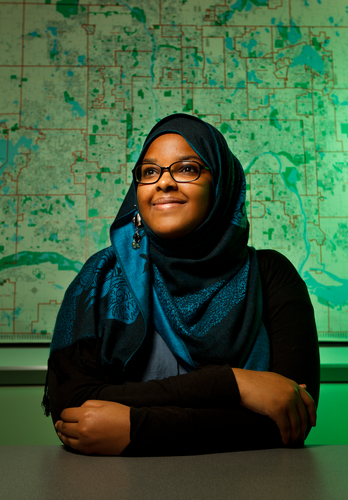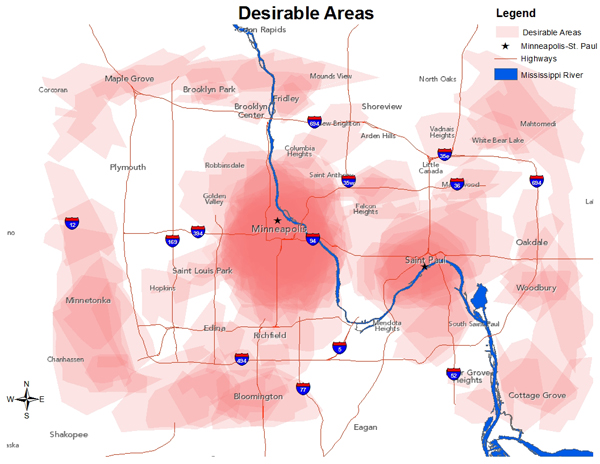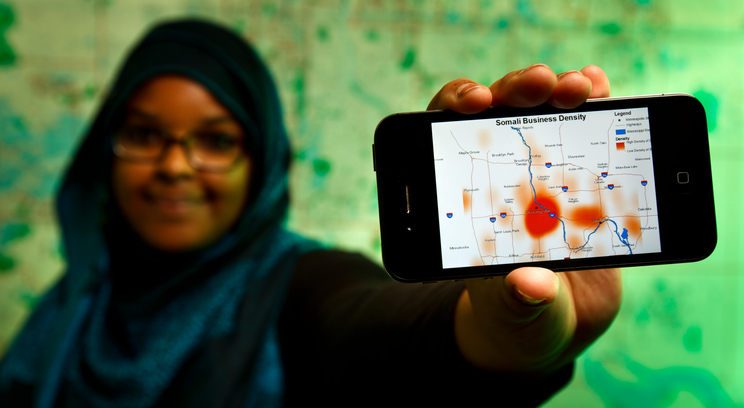Last semester, Fartun Dirie, a junior geography major, got inspired in Dr. Paul Lorah's (Geography Department, College of Arts and Sciences) Human Geography Class, where she was introduced to "mental maps," geographic visual tools used to show how people perceive their environments. Later, with the help of a Summer Housing Grant through the McNair Scholars program, and advising guidance from Lorah, Dirie was able to develop her idea of mental mapping Somalis living in the Twin Cities.
In her project, "Mental Maps: Gaining Insight Into the Diverse Somali Perceptions of Residential Desirability in the Twin Cities," Dirie, who was born in Somalia, studied how Somalis perceive the Twin Cities' landscape in terms of residential desirability.

Fartun Dirie
Dirie presented her research at the 2012 GIS/LIS Consortium annual conference, held Oct. 3 to 5, in St. Cloud, Minn., where she was awarded the undergraduate scholarship and first-place presentation award with cash prizes totaling $1,000.
To start, Dirie had to do some research to locate the areas with the highest concentration of Somalis, first identifying sections with the highest density of African Americans then narrowing that field to solely Somali residents. Eventually, she found the Cedar-Riverside neighborhood in south Minneapolis, and University Avenue between Rice and Hamline streets in St. Paul to have the highest density of Somalis.
Her data collection method was grass roots in style. Dirie randomly approached patrons – 68 in all, who varied in age from 18 to 70, of which about 40 percent were women − of various mosques, Somali community centers and Somali-owned businesses, all located in her pre-identified areas of high density, and asked each of them to color in a simple template mental map of the Twin Cities that she created: Red to mark geographical areas they would like to live if they had complete freedom to choose, blue to mark the areas they did not find desirable, and gray to mark the areas in which they spend most of their time.
Research findings
What Dirie discovered was heartening.
"What I found very interesting was that many of my survey participants did not list a place where they wouldn't want to live on their mental maps. This shows that, generally speaking, Somalis view the Twin Cities in a positive light," she said.
Participants also marked 103 areas where they would consider moving, which is significantly higher than the 78 areas participants noted they would not move to. This is further evidence that Somalis find more areas desirable than undesirable in the Twin Cities.
Her findings reinforce Minnesota's (particularly the Twin Cities') reputation as the "de facto Somali capital of the United States," she said. While doing background research, Dirie found that in 1994 there were virtually no Somali-owned businesses in Minneapolis/St. Paul. Today there are more than 550.
Somalia's history provides insight into these figures. An east African country, Somalia has been mired in war and political instability for more than two decades. After civil war broke out in 1988, resulting in the 1991 overthrow of the dictatorship government, many Somalis fled to neighboring African countries and elsewhere, including the United States. According to the 2010 U.S. Census, 100,000 Somalis now live in the United States, and at 32,000, Minnesota has the highest Somali population in the country.
"Like many Somalis, my family and I moved to the United States to flee the war in Somalia," Dirie recalled. Her family moved to the United States in 1994 when she was 2, settling first in Pennsylvania before heading west to Minnesota during the state's Somali boom.
"My parents moved to Minnesota specifically because they wanted to live among a thriving Somali community," she said.

A mental map created by Dirie illustrates how the 68 Twin Cities' Somalis she surveyed perceive their environment. The deepest red tones, seen here surrounding Minneapolis, show the residential areas they collectively found the most desirable.
City vs. Suburbia
Her results also showed that while most Twin Cities' Somalis spend the majority of their time near downtown St. Paul and Minneapolis, regardless of where they live, they have diverse views on the areas they consider residentially desirable. While some Somalis indicated they preferred urban areas to suburban, there also were many Somalis who preferred the opposite.
Dirie acknowledged that she would have liked to have incorporated additional socio-demographic factors − such as number of years living in the United States, level of English fluency and mode of transportation − into her study, but due to time constraints she chose to focus on just two: income and education level.
These factors illuminated a striking difference among Somalis with regard to who finds the suburbs residentially desireable.
Dirie found that the higher one's income, the more likely he or she was to mark the suburbs red (for desirable). Fifty-five percent of her subjects with incomes greater than $35,000 indicated they find the suburbs desirable, compared with 42 percent of those having incomes between $20,000 and $30,000, and 25 percent of those who make below $20,000. The same could be said for education: Forty-eight percent of college-educated participants indicated they find the suburbs desirable, compared to 33 percent of those with high school educations and 11 percent of those with little to no schooling.
Dirie said one explanation may be that "as Somalis climb higher on the socio-economic ladder, they acquire more resources and capital, which may make it easier for them to assimilate."
Regarding the urban centers of Minneapolis and St. Paul, income and education did not factor significantly into desirability.
Even among those subjects with the highest incomes and educations of those surveyed, Dirie found "a considerable number who preferred to spend most of their time downtown even if they don't live there."
Migration decisions
In addition to filling out mental maps, Dirie asked participants to answer a few demographic and open-ended questions to help her understand the factors that inform their decisions in choosing where to live. The majority indicated that good schools and educational opportunities attracted them to an area. Others factors cited were safe neighborhoods, proximity to family, ethnic network and job opportunities.
Mapping her own future
Lorah, Dirie's adviser on the project, called her "thoughtful and enthusiastic." He added, "New students have the ability to gain insight into culture by modeling data in a GIS environment. She gets the theory, she has strong technical skills, and she uses both in creative ways. I'm looking forward to finding out what her next project is going to be."
And so does Dirie.
“Research at St. Thomas was a great experience! While finishing up my research, I realized my work is never really over. I found myself left with even more curiosity and many more ideas and topics I hope to research in the future.”
With two years of undergraduate work still to go, she already has begun to map her own future.
"My plan is to attend graduate school for either geography or public health and obtain a Ph.D. I’m interested in studying migration as well as GIS (Geographic Information Systems) technology and its applicability within fields like public health," she said.
“After completing my doctorate, I hope to work in international development. I’m still very interested in studying mental maps. I think it would be really interesting to see how people’s perception of their environments influences areas such as urban planning, community development or even health care accessibility. ”







